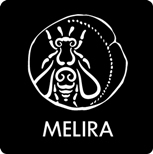Melira Honey
Melira was founded in Athens in November, 2014, by Panos Alexiou in order to incorporate family tradition, marry it with contemporary marketing, and develop a series of products aimed not only at Greece, but mainly abroad. With deep knowledge of the raw material and a significant production of honey, pollen, royal jelly, and propolis, 3 series of products are developed, such as honey, superfoods and beeswax salve.
The Alexiou family is the third generation of honey producers, with a history beginning in 1935 in Istiaia, Euboea. At the time, the family’s grandfather, Stathis Alexiou, used to sell his honey and royal jelly at the local market. Later, the beekeeping was undertaken by his son, Giannis, who was initiated into the secrets of Queen Rearing by an American agronomist. Nowadays, Giannis’ four children carry on the production with the same fervor, but also through modern techniques.
Melira’s logo is comprised of a sketched rendition of the tetradrachm of Ephesus -on which a bee was depicted- that connects to the worship of Artemis of Ephesus and her priestesses, known as the “Mellissae”. The pun in the word “Melira” connects the coins to the honey, while on a second level it signifies the timeless value of this natural food.
The honey mainly comes from the company-owned beehives, which are transported -depending on the season- from Thrace to the Dodecanese in order to give out fragrances, such as anise, linden, sage, lemon blossom, orange, chestnut, wild oak tree, heather and thyme.
Producer's Products
Attica
Attica is the historic region of Greece which encompasses the city of Athens, which is also the capital of Greece, and the city of Piraeus. Since 1829, Attica has belonged to the independent Greek state. Since 1834, Athens has been rebuilt and has become the new capital of Greece (transferred from Nafplio in Argolis), and people from other parts of Greece have gradually started reconstituting Attica. The most dramatic increase happened with the Greek refugees from Asia Minor, after the population exchange between Greece and Turkey, in the context of the Treaty of Lausanne. Today, a large part of Attica is occupied by urban Athens. The contemporary Greek region of Attica incorporates the classical Attica, as well as the islands of the Argo-Saronic Gulf, a small part of Peloponnese surrounding Troezen, and the Ionian island Kithira.
Since ancient times, Attica has been a fruitful area with excellent products. There are valleys in Eleusis, and the Mesogeia, which are being cultivated and are very fertile. They produce mainly grapes, agricultural products, vegetables, honey and olives. In Attica, resin from pine trees, marbles and lignite are also produced. Even its sea is rich in fish. In recent years, many important producers have chosen Attica as the commercial center of Greece and simultaneously as an important gateway to Europe.


